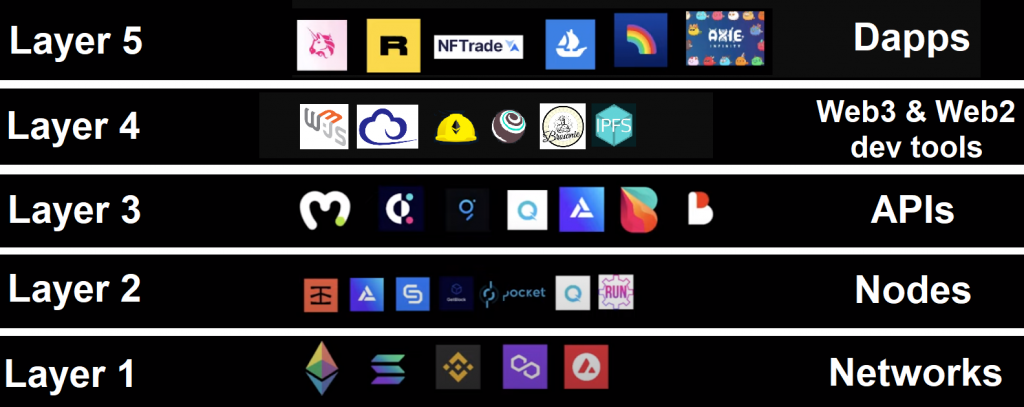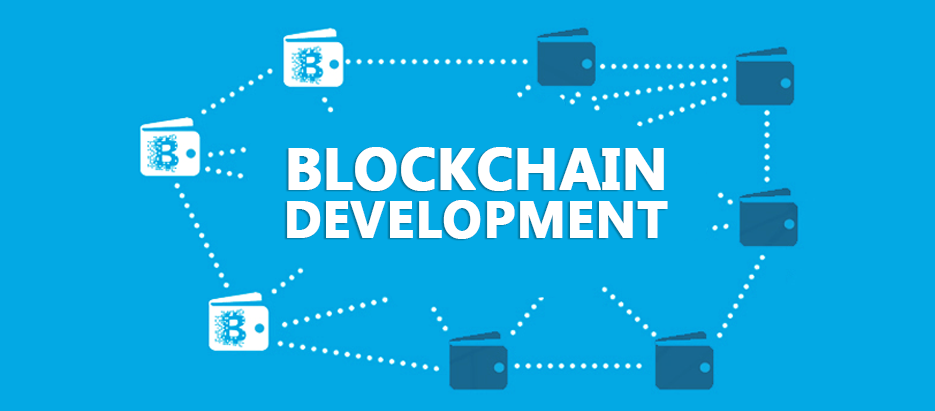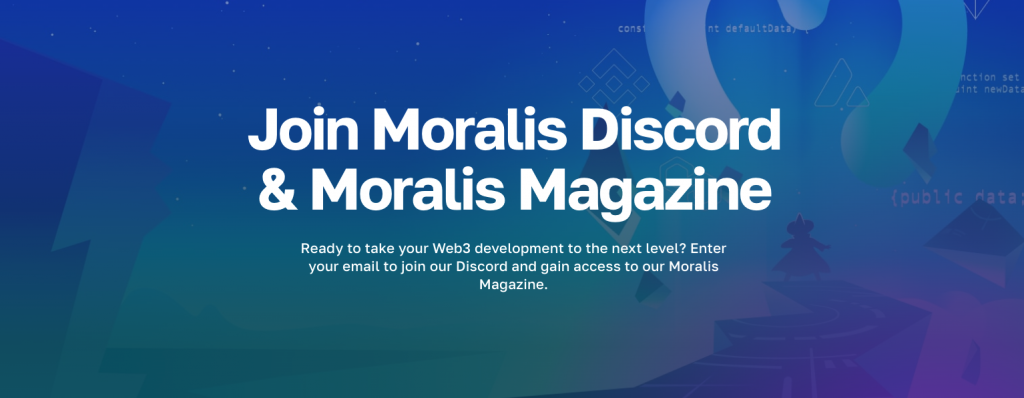Do you want to develop blockchain networks, or do you have the urge to help build tools for Web3 developers? Or do you want to focus on delivering decentralized applications (dapps) – the end products users can interact with? Each task involves focusing on different layers of the blockchain tech stack. As such, it’s beneficial to understand what the current tech stack for blockchain looks like so you can decide which layer you want to focus on specifically.
There are different ways to break down the current blockchain tech stack. It all depends on how someone categorizes the available tools and solutions. However, we prefer to view the technology stack for blockchain development in five layers. Moving forward, we’ll take a closer look at each of these five layers to provide you with a clear explanation of each layer. By adding that information to your knowledge base, you’ll be able to decide which layer you want to focus on moving forward. Now, if you’re coming from the legacy system and are, for instance, JavaScript (JS) proficient, the path of the least resistance is to start creating killer dapps. After all, when you use tools such as Moralis, your JS skills can get you incredibly far. Moreover, you can start by simply creating a free Moralis account. That said, let’s now get a bird’s-eye view of the blockchain tech stack!

A Blockchain Developer’s Tech Stack Guide
Let’s take a closer look at each of the five blockchain tech stack layers below. However, before examining each individually, we want you to get a complete picture of what the tech stack for blockchain looks like. The following image will be extremely beneficial:

Starting at the bottom, the above image displays different programmable chains, also known as layer-1 (L1) blockchains. However, layer-2 (L2) blockchains also fall into the first layer of the blockchain developer tech stack. Moreover, these chains serve as the networks, protocols, and databases for on-chain data, which makes the decentralized internet possible.
Above the blockchain networks, we have nodes, APIs, Web3 and Web2 dev tools and platforms, and finally, dapps (decentralized applications) at the very top. These five layers together form the current technology stack for blockchain development. Although, if you want to be a dapp developer, you don’t need to worry about all these layers. Moreover, since the above image is essential, keep it in mind as we proceed with our discussion.
Which of the above five levels do you think most users care about? If your answer is “dapps”, you are correct. Hence, make sure to keep this important fact in your mind at all times. After all, without user-friendly dapps, blockchain tech is nothing but a piece of technology that no one uses. Thus, knowing how to create dapps is essential for the survival of Web3. Also, we must reach the end users as effectively and efficiently as possible.

Technology Stack for Blockchain Development
With the above-presented overview under your belt, you are ready to get better acquainted with each of the five layers. We will start at the bottom and work our way up. By getting familiar with the blockchain developer tech stack layers, you’ll be able to take your next steps confidently.
Layer 1: Networks
It’s time to take a closer look at the first layer of the blockchain tech stack. This is the layer that makes blockchain development and Web3 possible. Without it, we are stuck to centralized networks. Moreover, the Ethereum chain is still the king among programmable blockchains, and it continues to be the most popular decentralized network. After all, it was the first of its kind and, in turn, had the first-mover advantage. Nonetheless, Ethereum’s beginning also resulted in the Ethereum Virtual Machine (EVM) formation. However, as you may know, Ethereum’s high transaction fees and network congestion sparked the birth of other chains. Hence, we now have several reputable alternatives.

Furthermore, development blockchains can be split primarily into two categories: EVM-compatible chains and non-EVM-compatible chains. As the name suggests, the former chains use the same virtual environment as Ethereum. Thus, by focusing on these chains, you can use most of the same dev tools as you’d for Ethereum. On the other hand, non-EVM-compatible chains use their original virtual environments. Here are some popular examples of both types of blockchains:
- Layer-1 Blockchains:
- Ethereum – Original EVM smart contract platform
- Avalanche – EVM-compatible L1 blockchain
- Cronos – EVM-compatible L1 blockchain
- Fantom – EVM-compatible L1 blockchain
- BNB Chain – EVM-compatible L1 blockchain
- Solana – Non-EVM-compatible L1 blockchain
- NEAR – Non-EVM-compatible L1 blockchain
- Flow – Non-EVM-compatible L1 blockchain
- Layer-2 Blockchains (All Listed Below are EVM Compatible):
- Polygon – Ethereum sidechain (L2 solution)
- Arbitrum – L2 blockchain using optimistic rollups and multi-round fraud proofs
- Optimism – L2 blockchain using optimistic rollups and single-round fraud proofs
- Hermez – A zk-rollup Ethereum L2 network managed by the Polygon chain
Note: If you want to develop dapps, focus on dev tools that enable you to switch between the chains easily.
Layer 2: Nodes
Essentially, nodes connect with other nodes on the same chain. Every full node (there are also other types) contains a complete copy of the current blockchains state. Furthermore, the overall distribution of the nodes in a specific blockchain network determines the level of the network’s decentralization tier. Additionally, running a node is essential as nodes enable you to speak with the blockchain and access its data. Moreover, it’s helpful to use a CPU analogy here. You don’t interact with the CPU when creating Web2 applications. Similarly, it makes sense not to interact directly with a blockchain.

However, while technically anyone can run a node, it’s not that simple. In many cases, running a node is a full-time job, requiring a team for maintenance, proper backup, and much more. Thus, it would be silly to expect every Web3 developer to run their own node. Fortunately, you don’t have to because several specialized node providers already exist. Node providers are the core of this layer of the blockchain developer tech stack. Furthermore, some of the most popular and reputable node providers include Infura, Alchemy, Chainstack, Getblock, Pocket Network, QuickNode, and RunNode.
Unfortunately, a node can only focus on a specific chain and can’t cover multiple smart contracts behind crypto tokens. Moreover, a node can only provide you with raw data from the blockchain.
Layer 3: APIs
Unless you are completely new to computer science, you know that APIs (application programming interfaces) are sets of definitions and protocols for building and integrating applications. When we transition this to blockchain, Web3 APIs support dapp development.

Essentially, APIs offer a neat way for a piece of software to interact with other pieces of software. Furthermore, quality APIs enable consistent coding in a stable environment. As such, you’d be happy to hear that there are several reputable Web3 API providers. Note-worthy mentions include Covalent, QuickNode, The Graph, Bitquery, Alchemy, and Biconomy. However, the industry-leading Web3 API provider is Moralis. Thanks to its cross-chain and cross-platform interoperability, Moralis’ enterprise-grade APIs empower you to build, scale, and connect dapps cross-chain through a singular framework. This reduces development time, cost, and complexity, removes silos, and brings greater interoperability to blockchain projects. As a result, you can establish a solid and future-proof Web3 infrastructure.
Moreover, the API providers have different APIs that connect to the nodes behind the scenes. Thus, you don’t have to worry about that yourself. This makes APIs the most important blockchain tech stack layer for dapp development. By interacting with this technology stack for blockchain development, you can obtain all sorts of useful precompiled and precalculated on-chain data.
In addition, it’s worth pointing out that all API providers offer documentation where details about their APIs are explained. For instance, Moralis’ documentation even provides practical examples for its broad range of useful endpoints. In turn, you get to cover many queries with short snippets of code.
Layer 4: Web3 and Web2 Dev Tools and Platforms
It’s worth pointing out that we could merge the third and fourth layers of the tech stack for blockchain into a single layer. After all, APIs are also development tools. However, they make such a huge difference that, in our opinion, they deserve a separate layer.

Moreover, since the fourth layer includes higher-level software abstractions and frontend libraries, it can also be referred to as the presentation layer. It includes Web3 native libraries, developer environments, and decentralized file storage solutions (e.g., IPFS). In addition, this blockchain developer tech stack layer also includes legacy application development platforms. Thanks to quality cross-platform APIs (like those offered by Moralis), you can use popular platforms, such as Firebase, Supabase, and PlayFab, to create killer dapps.
Layer 5: Dapps
We’ve reached the top layer of the blockchain developer tech stack – dapps. Decentralized applications come in countless forms. They can be DeFi dashboards, DEXs, identity and authentication dapps, NFT marketplaces, data handling dapps, and many others. Furthermore, as pointed out previously, all lower layers of the blockchain tech stack come to life with this top layer. When it comes to Web3 users, this is the only layer they will directly interact with. However, while you, as a Web3 dev, will primarily focus on creating dapps, you will also use some existing dapps to simplify your work. For instance, you’ll use Web3 wallets (e.g., MetaMask) to cover transaction fees when deploying smart contracts and to test your dapps.

It’s important to keep in mind that this layer of the blockchain developer tech stack enables you to be creative. It’s up to you to deliver a spectacular UI and offer the best possible UX. After all, these aspects of dapps contribute to the mainstream adoption of blockchain technology.
Ultimately, by using the best tools that the current blockchain developer tech stack has to offer, you can save time and resources on developing and reinventing blockchain-related backend features. Instead, you’ll be able to devote your full attention to creating the best possible frontend.

Start Building Using the Blockchain Tech Stack Tools
Here are the essential tools of the blockchain tech stack you must utilize to start creating killer dapps:
- Code editor/IDE (e.g., Visual Studio Code [VSC])
- Proficiency in one of the popular legacy programming languages (e.g., JavaScript)
- A free Moralis account, which provides you with your Web3 API key. Then, you can install the Moralis SDK and utilize Moralis’ products:
- EVM API
- Solana API
- NFT API
- Auth API (seamless Web3 authentication solutions)
- Streams API (stream blockchain data into your backend via Web3 webhooks)
- Token API
With the above tools, you can follow along in the tutorials inside the Moralis documentation and have your first dapp ready in minutes. Moralis also offers support for IPFS; hence, you can easily store your files in a decentralized manner. Also, since Moralis is cross-chain interoperable, you can target all supported chains and switch between them without friction.

Furthermore, while the above-listed tools are enough to get you going and create a wide range of dapps, you’ll most likely want to learn how to program smart contracts. In that case, we recommend learning Solidity and using other EVM-compatible smart contract programming solutions (Remix, Hardhat, etc.). This will give you more options as you can deploy smart contracts on Ethereum and all EVM-compatible chains. However, if you prefer Solana, the Rust programming language is your best choice.

The Ultimate Blockchain Tech Stack Guide – Summary
In today’s guide, you learned the basics of the current technology stack for blockchain development. We started with a quick overview, where you learned that the blockchain tech stack includes five layers. Then, we took a closer look at each of these layers. As such, you now know what the key aspects of each layer are and which layer you should focus on if you want to develop dapps the easy way. Ultimately, these are the five layers of the current tech stack for blockchain:
- Layer 1: Blockchain Networks
- Layer 2: Nodes and Node Providers
- Layer 3: Web3 APIs and Web3 API Providers
- Layer 4: Web3 and Web3 Dev Tools and Platforms
- Layer 5: Decentralized Applications
Last but not least, you learned that your JavaScript proficiency and a free Moralis account are enough to start creating dapps. Hence, you might be eager to complete the Moralis onboarding now.
On the other hand, you might be interested in learning more about blockchain development. In that case, we recommend one of these two options:
- Use the Moralis YouTube channel and the Moralis blog to become a Web3 developer for free. Some of the latest topics there will teach you how to create a Web3 Firebase login with MetaMask, how to create a decentralized website on Ethereum, how to go about Solana smart contract building, how to add dynamic Web3 authentication to a website, and much more.
- Enroll in Moralis Academy to take a more professional approach to your blockchain development education. If you already have the basics under your belt, it might be time to master DeFi.
